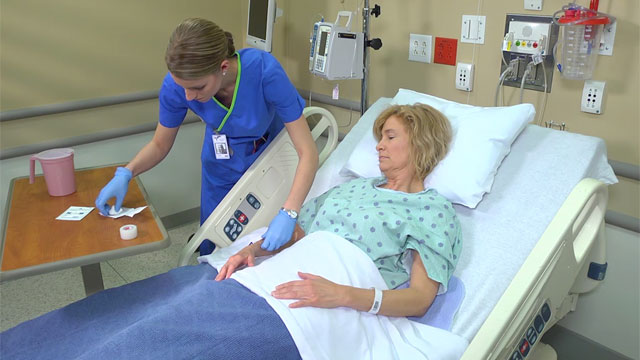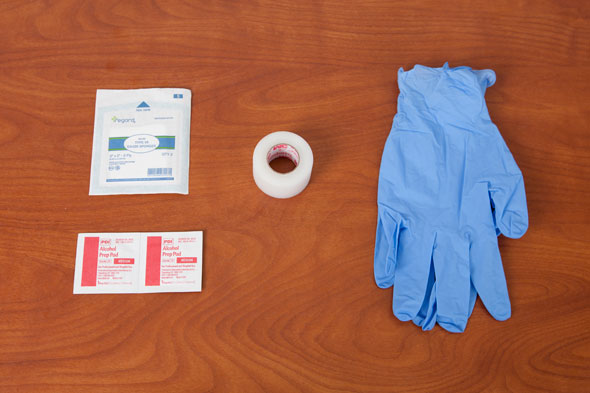Administering Intravenous Fluid Therapy
Select a Skill:
- » Preparing an Infusion Site
- » Performing Venipuncture
- » Dressing the Infusion Site
- » Troubleshooting Intravenous Infusions
- » Discontinuing Intravenous Therapy
Take the Review Test:

Safety
- Follow infection prevention guidelines to minimize the chance of the patient’s acquiring an infection.
- Use caution to avoid breaking off the catheter during removal, since a damaged catheter increases the risk for embolus formation.
- Never use scissors to remove the tape or dressing because you may accidentally cut the catheter.
- To avoid trauma and possible hematoma formation, do not raise or lift the catheter before it has been completely removed from the vein.
Equipment
(Roll cursor over items to see labels)

Antiseptic swabs
2x2 inch gauze pads
Tape
Clean gloves
Delegation
The skill of discontinuing a short peripheral intravenous line may not be delegated to nursing assistive personnel (NAP). Delegation to licensed practical nurses (LPNs) varies by state Nurse Practice Act. Be sure to inform NAP of the following:
- Instruct NAP to report to you any bleeding at the site after the catheter has been removed.
- Instruct NAP to report to you any complaints of pain by the patient or observations of redness at the site.
Preparation
- Observe the existing IV site for signs and symptoms of IV-related complications, such as pain, infiltration, phlebitis, and exudate.
- Assess if the patient is receiving an anticoagulant or has a history of a coagulopathy.
- Review the accuracy and completeness of the health care provider’s orders to discontinue IV therapy.
- Assess the patient’s understanding of the need to discontinue the IV.
Follow-up
- Observe the site for evidence of any complications, such as bleeding, pain, exudate, and swelling.
Documentation
Document the procedure in the patient’s medical record.
Review Questions
1. What would the nurse do to assess a patient’s risk for embolus when removing a venous access device?
 Inspect the site for redness.
Inspect the site for redness. Visualize the tip of the IV device.
Visualize the tip of the IV device. Palpate the site for possible edema.
Palpate the site for possible edema. Ask the patient to rate any pain at the site.
Ask the patient to rate any pain at the site.
2. Which instruction might the nurse give to nursing assistive personnel (NAP) when caring for a patient whose IV access device is to be removed?
 “Remember to wear gloves to minimize the risk for infection.”
“Remember to wear gloves to minimize the risk for infection.”  “Be sure to keep pressure on the site for at least 2 to 3 minutes.”
“Be sure to keep pressure on the site for at least 2 to 3 minutes.”  “Let me know if you notice any bleeding on the site dressing.”
“Let me know if you notice any bleeding on the site dressing.”  “Make sure the patient knows to notify me if the IV site becomes painful.”
“Make sure the patient knows to notify me if the IV site becomes painful.”
3. What might the nurse do to improve a patient’s cooperation during the removal of an IV access device?
 Describe the entire procedure to the patient.
Describe the entire procedure to the patient. Assure the patient that you will remove the IV catheter quickly.
Assure the patient that you will remove the IV catheter quickly. Assure the patient that the procedure will take only about 5 minutes.
Assure the patient that the procedure will take only about 5 minutes. Tell the patient that the procedure will cause only a slight burning sensation.
Tell the patient that the procedure will cause only a slight burning sensation.
4. Which action will best minimize the patient’s risk for vein injury when removing an IV access device from a patient’s arm?
 Keep the hub parallel to the skin.
Keep the hub parallel to the skin. Cleanse the site with an antibacterial swab.
Cleanse the site with an antibacterial swab. Cut the dressing to facilitate its removal.
Cut the dressing to facilitate its removal. Turn the IV tubing roller clamp to the “off” position.
Turn the IV tubing roller clamp to the “off” position.
5. What will the nurse do to prevent possible complications after removing an IV access device in a patient on anticoagulant therapy?
 Instruct the patient to report immediately any sign of bleeding on the site dressing.
Instruct the patient to report immediately any sign of bleeding on the site dressing. Perform hand hygiene and wear clean gloves while removing the device.
Perform hand hygiene and wear clean gloves while removing the device. Encourage the patient to keep a cold compress on the site for 15 minutes.
Encourage the patient to keep a cold compress on the site for 15 minutes. Apply firm pressure to the site with sterile gauze for 10 minutes.
Apply firm pressure to the site with sterile gauze for 10 minutes.
You have completed the Review Questions for this skill. To take the Review again select the Start Over button. To proceed to another skill select from the dropdown menu. Select the Home or Back button to proceed to the next section.

